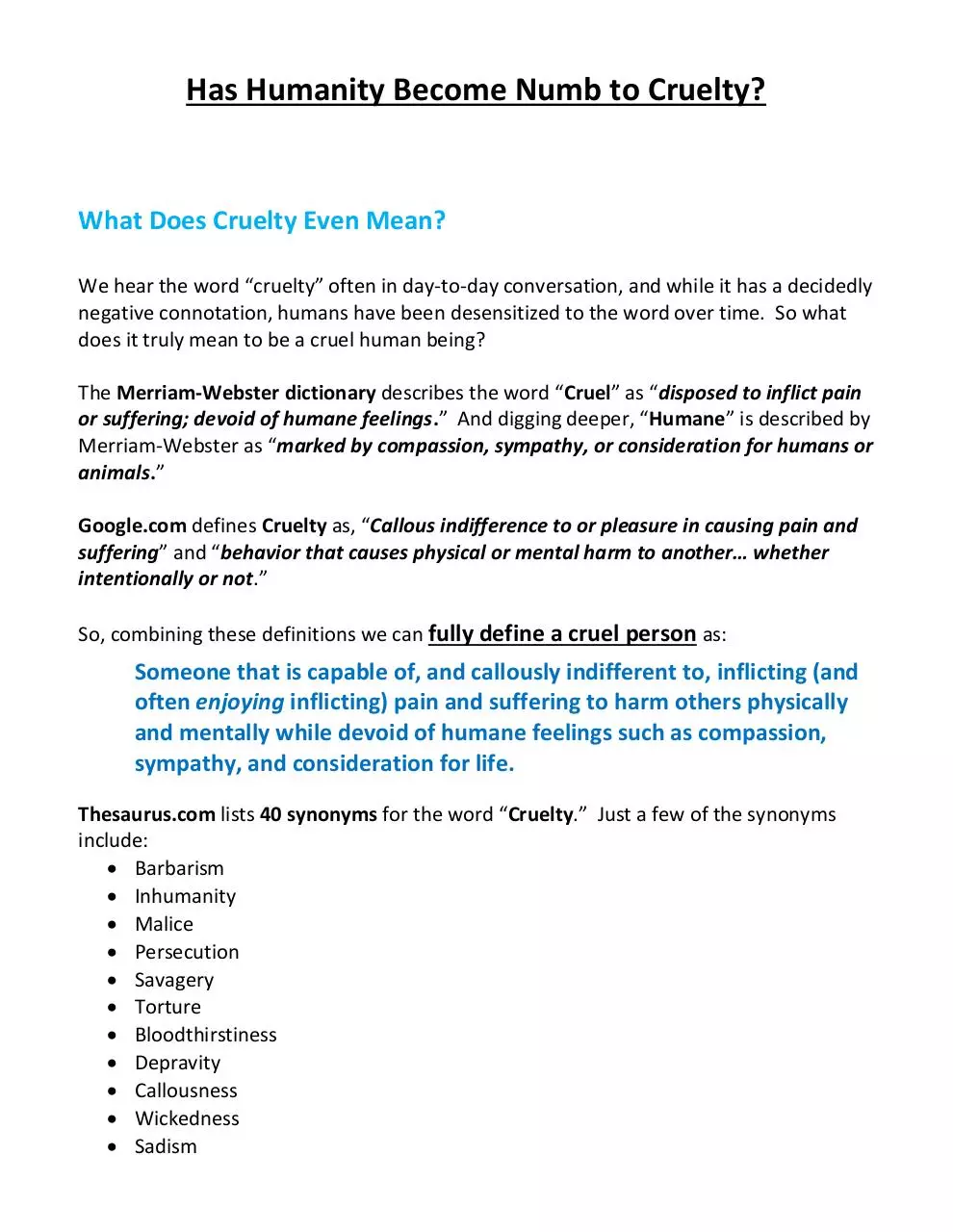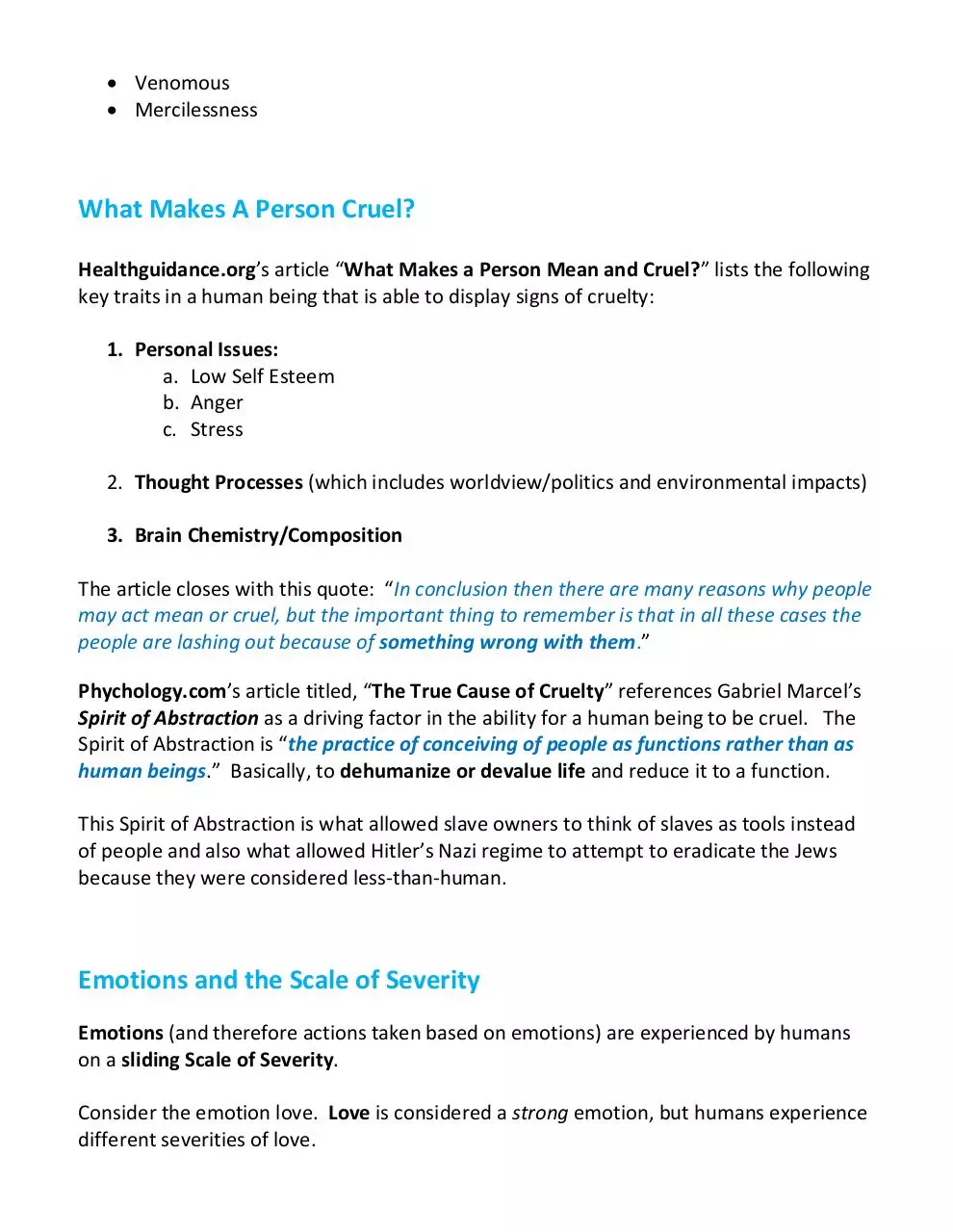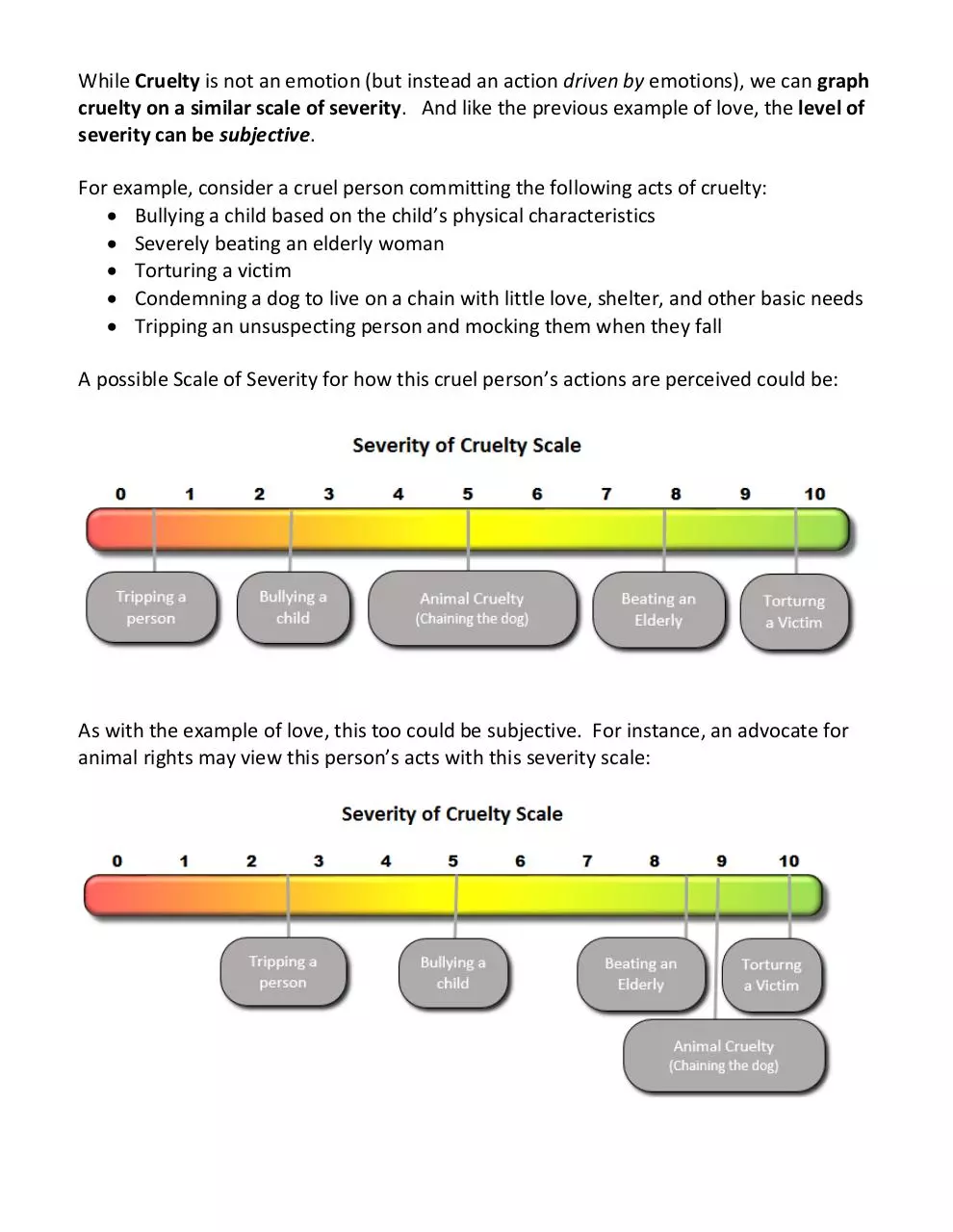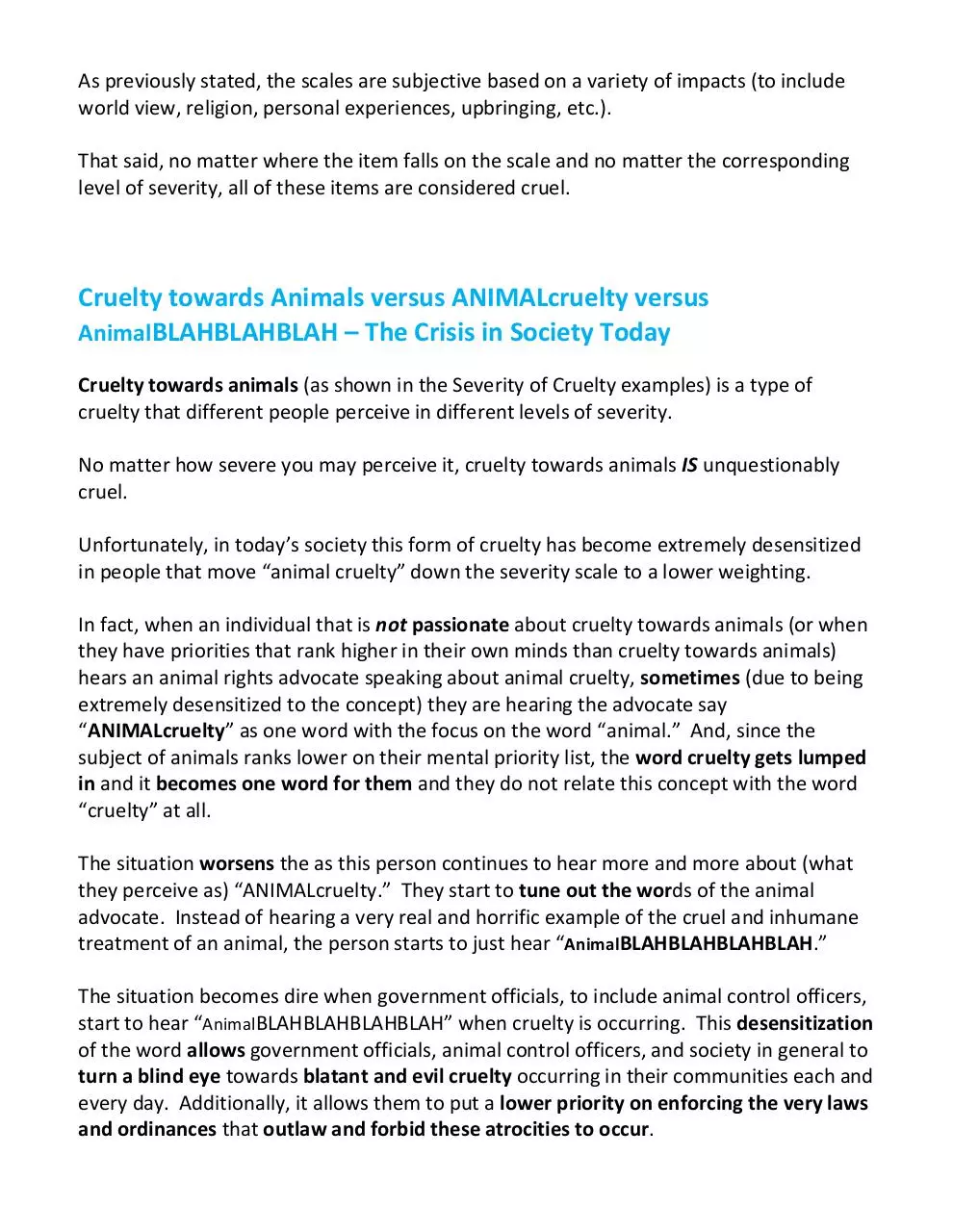Has Humanity Become Numb to Cruelty (PDF)
File information
Author: Joshua Noullet
This PDF 1.5 document has been generated by Microsoft® Word 2010, and has been sent on pdf-archive.com on 27/02/2018 at 00:37, from IP address 24.214.x.x.
The current document download page has been viewed 384 times.
File size: 596.15 KB (7 pages).
Privacy: public file





File preview
Has Humanity Become Numb to Cruelty?
What Does Cruelty Even Mean?
We hear the word “cruelty” often in day-to-day conversation, and while it has a decidedly
negative connotation, humans have been desensitized to the word over time. So what
does it truly mean to be a cruel human being?
The Merriam-Webster dictionary describes the word “Cruel” as “disposed to inflict pain
or suffering; devoid of humane feelings.” And digging deeper, “Humane” is described by
Merriam-Webster as “marked by compassion, sympathy, or consideration for humans or
animals.”
Google.com defines Cruelty as, “Callous indifference to or pleasure in causing pain and
suffering” and “behavior that causes physical or mental harm to another… whether
intentionally or not.”
So, combining these definitions we can fully define a cruel person as:
Someone that is capable of, and callously indifferent to, inflicting (and
often enjoying inflicting) pain and suffering to harm others physically
and mentally while devoid of humane feelings such as compassion,
sympathy, and consideration for life.
Thesaurus.com lists 40 synonyms for the word “Cruelty.” Just a few of the synonyms
include:
Barbarism
Inhumanity
Malice
Persecution
Savagery
Torture
Bloodthirstiness
Depravity
Callousness
Wickedness
Sadism
Venomous
Mercilessness
What Makes A Person Cruel?
Healthguidance.org’s article “What Makes a Person Mean and Cruel?” lists the following
key traits in a human being that is able to display signs of cruelty:
1. Personal Issues:
a. Low Self Esteem
b. Anger
c. Stress
2. Thought Processes (which includes worldview/politics and environmental impacts)
3. Brain Chemistry/Composition
The article closes with this quote: “In conclusion then there are many reasons why people
may act mean or cruel, but the important thing to remember is that in all these cases the
people are lashing out because of something wrong with them.”
Phychology.com’s article titled, “The True Cause of Cruelty” references Gabriel Marcel’s
Spirit of Abstraction as a driving factor in the ability for a human being to be cruel. The
Spirit of Abstraction is “the practice of conceiving of people as functions rather than as
human beings.” Basically, to dehumanize or devalue life and reduce it to a function.
This Spirit of Abstraction is what allowed slave owners to think of slaves as tools instead
of people and also what allowed Hitler’s Nazi regime to attempt to eradicate the Jews
because they were considered less-than-human.
Emotions and the Scale of Severity
Emotions (and therefore actions taken based on emotions) are experienced by humans
on a sliding Scale of Severity.
Consider the emotion love. Love is considered a strong emotion, but humans experience
different severities of love.
For instance, a woman may love her best friend. She may feel an even deeper sense of
love for her husband. And maybe she experiences an even deeper sense of love for her
child or mother. So, she’s experiencing the emotion of love for all of those people, but at
different levels of severity. Her “Severity of Love” scale might look something like this:
She loves all of these people, but she loves them in different degrees of severity.
Additionally, not all people experience love with the same severity. A man had a poor
relationship with his mother growing up but he has developed a deep family-like bond
with his best friend. His severity of love scale might look like this:
As we can see, both the man and the woman love the same people in this example.
However, they feel different severities of love depending on their life experiences.
Despite this severity, the emotion experienced for each person is love.
While Cruelty is not an emotion (but instead an action driven by emotions), we can graph
cruelty on a similar scale of severity. And like the previous example of love, the level of
severity can be subjective.
For example, consider a cruel person committing the following acts of cruelty:
Bullying a child based on the child’s physical characteristics
Severely beating an elderly woman
Torturing a victim
Condemning a dog to live on a chain with little love, shelter, and other basic needs
Tripping an unsuspecting person and mocking them when they fall
A possible Scale of Severity for how this cruel person’s actions are perceived could be:
As with the example of love, this too could be subjective. For instance, an advocate for
animal rights may view this person’s acts with this severity scale:
As previously stated, the scales are subjective based on a variety of impacts (to include
world view, religion, personal experiences, upbringing, etc.).
That said, no matter where the item falls on the scale and no matter the corresponding
level of severity, all of these items are considered cruel.
Cruelty towards Animals versus ANIMALcruelty versus
AnimalBLAHBLAHBLAH – The Crisis in Society Today
Cruelty towards animals (as shown in the Severity of Cruelty examples) is a type of
cruelty that different people perceive in different levels of severity.
No matter how severe you may perceive it, cruelty towards animals IS unquestionably
cruel.
Unfortunately, in today’s society this form of cruelty has become extremely desensitized
in people that move “animal cruelty” down the severity scale to a lower weighting.
In fact, when an individual that is not passionate about cruelty towards animals (or when
they have priorities that rank higher in their own minds than cruelty towards animals)
hears an animal rights advocate speaking about animal cruelty, sometimes (due to being
extremely desensitized to the concept) they are hearing the advocate say
“ANIMALcruelty” as one word with the focus on the word “animal.” And, since the
subject of animals ranks lower on their mental priority list, the word cruelty gets lumped
in and it becomes one word for them and they do not relate this concept with the word
“cruelty” at all.
The situation worsens the as this person continues to hear more and more about (what
they perceive as) “ANIMALcruelty.” They start to tune out the words of the animal
advocate. Instead of hearing a very real and horrific example of the cruel and inhumane
treatment of an animal, the person starts to just hear “AnimalBLAHBLAHBLAHBLAH.”
The situation becomes dire when government officials, to include animal control officers,
start to hear “AnimalBLAHBLAHBLAHBLAH” when cruelty is occurring. This desensitization
of the word allows government officials, animal control officers, and society in general to
turn a blind eye towards blatant and evil cruelty occurring in their communities each and
every day. Additionally, it allows them to put a lower priority on enforcing the very laws
and ordinances that outlaw and forbid these atrocities to occur.
As this concept further solidifies, the severity scale of our example group of
“AnimalBLAHBLAHBLAH” no longer even categorizes the cruel and inhumane treatment of
animals as a form of cruelty. In fact, their Severity Scale of Cruelty has subconsciously
shifted to removing animal cruelty completely:
This trend needs to be reversed in order for government officials, animal control officers,
law enforcement, and society as a whole to increase their own priority level and views of
cruelty towards animals.
To do so, the concepts outlined in this document need to be driven home so that this
group can truly understand that cruelty (not AnimalBLAHBLAHBLAH) is occurring and
cruelty of all kinds is wrong.
A person that is capable of being cruel to an animal is a person that is scientifically
categorized as a cruel person committing a cruel act.
As we know, Animal Cruelty almost always leads to other forms of cruelty and human
violence. Therefore, when law enforcement offers are called to animal cruelty cases,
they should view these cases not as AnimalBLAHBLAHBLAH but as physiologically
deficient human behaviors that will downward spiral if not handled immediately.
A Google search for “animal cruelty and human violence” turns up 2.14 million articles. A
few of those articles include:
The Huffington Post wrote an article detailing the connection (and natural
progression) between Animal Cruelty and Human Violence
(https://www.huffingtonpost.com/cathy-kangas/animal-cruelty-and-human_b_2507551.html).
The National District Attorneys Association has put out an 84-page .pdf outlining
the link between Animal Cruelty and Human Violence:
http://www.ndaa.org/pdf/The%20Link%20Monograph-2014.pdf
In summary:
1. Cruelty is defined as someone that is capable of, and callously indifferent to,
inflicting (and often enjoying inflicting) pain and suffering to harm others
physically and mentally while devoid of humane feelings such as compassion,
sympathy, and consideration for life.
2. Healthguidance.org has listed cruelty as a mental deficiency and, after defining
attributes of a cruel person, summarizes with:
“In conclusion then there are many reasons why people may act mean or
cruel, but the important thing to remember is that in all these cases the
people are lashing out because of something wrong with them.”
3. Phychology.com’s article, “The True Cause of Cruelty” explains the Spirit of
Abstraction as a driving factor in the ability for a human being to be cruel, defining
this as “the practice of conceiving of people as functions rather than as human
beings.” Or dehumanizing or devaluing life and reducing it to a function.
4. People experience/observe cruelty on a sliding Scale of Severity. And, despite
varying perceptions of the severity of types of cruelty, cruelty is cruelty.
5. Cruelty toward animals
=
Cruelty.
a. Cruelty towards animals
b. Cruelty towards animals
≠
≠
ANIMALcruelty
AnimalBLAHBLAHBLAH
6. Animal Cruelty leads to and escalates to further cruelty, human violence, and
depravity.
7. Government officials, animal control, law enforcement, etc. MUST understand
these concepts in order to feel motivation to take action and enforce laws
preventing the cruel and inhumane treatment of animals, which in turn keeps our
society safer and happier as a whole.
Document updated 2/26/2018 12:07pm.
Property of ChainFreeDogs Columbus, Georgia.
Point-of-contacts: Christy Noullet, founder ChainFreeDogs
Download Has Humanity Become Numb to Cruelty
Has Humanity Become Numb to Cruelty.pdf (PDF, 596.15 KB)
Download PDF
Share this file on social networks
Link to this page
Permanent link
Use the permanent link to the download page to share your document on Facebook, Twitter, LinkedIn, or directly with a contact by e-Mail, Messenger, Whatsapp, Line..
Short link
Use the short link to share your document on Twitter or by text message (SMS)
HTML Code
Copy the following HTML code to share your document on a Website or Blog
QR Code to this page

This file has been shared publicly by a user of PDF Archive.
Document ID: 0000738991.